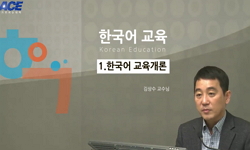The purpose of this study is to analyze the validity and practicality of cultural elements in Korean language education by analyzing the cultural elements of a textbook produced abroad, and comparing these with the respective national standards for th...
http://chineseinput.net/에서 pinyin(병음)방식으로 중국어를 변환할 수 있습니다.
변환된 중국어를 복사하여 사용하시면 됩니다.
- 中文 을 입력하시려면 zhongwen을 입력하시고 space를누르시면됩니다.
- 北京 을 입력하시려면 beijing을 입력하시고 space를 누르시면 됩니다.
https://www.riss.kr/link?id=T15480438
- 저자
-
발행사항
서울 : 韓國外國語大學校 敎育大學院, 2020
-
학위논문사항
학위논문(석사) -- 韓國外國語大學校 敎育大學院 , 외국어로서의한국어교육전공 , 2020. 2
-
발행연도
2020
-
작성언어
한국어
- 주제어
-
DDC
495.107 판사항(22)
-
발행국(도시)
서울
-
기타서명
An analysis on the cultural elements in a Korean textbook abroad : focusing on the 'Integrated Korean' series
-
형태사항
v, 122 p. : 삽도 ; 26 cm
-
일반주기명
한국외국어대학교 논문은 저작권에 의해 보호받습니다.
지도교수: 김재욱
참고문헌: p. 97-102 -
UCI식별코드
I804:11059-200000282713
- 소장기관
-
0
상세조회 -
0
다운로드
부가정보
다국어 초록 (Multilingual Abstract)
As the importance of cultural education in Korean language education has emerged, research on the categorization and hierarchization of cultural elements in Korean textbooks and syllabuses has been conducted continuously since the early 2000s. The current trends in the analysis of cultural factors in Korean language textbooks focuses on Korean language education using domestic textbooks. According to Kim, S. et al. (2015), since there are difficulties in using Korean textbooks made for the curriculum of domestic universities abroad, it is common to use both overseas published textbooks and domestic ones together. Therefore, it is relevant to analyze not only domestic published textbooks but also textbooks published abroad in order to study how to improve cultural education contents for overseas Korean language education.
The significance of this study is that it emphasizes the importance of cultural education in domestic and international Korean language education; analyzes the cultural elements of a textbook produced overseas used in Korean language education abroad, and proposes supplements to the contents of cultural education.
The purpose of this study is to analyze the validity and practicality of cultural elements in Korean language education by analyzing the cultural elements of a textbook produced abroad, and comparing these with the respective national standards for the efficient education of culture in domestic and overseas Korean language education.
As the importance of cultural education in Korean language education has emerged, research on the categorization and hierarchization of cultural elements in Korean textbooks and syllabuses has been conducted continuously since the early 2000s. The current trends in the analysis of cultural factors in Korean language textbooks focuses on Korean language education using domestic textbooks. According to Kim, S. et al. (2015), since there are difficulties in using Korean textbooks made for the curriculum of domestic universities abroad, it is common to use both overseas published textbooks and domestic ones together. Therefore, it is relevant to analyze not only domestic published textbooks but also textbooks published abroad in order to study how to improve cultural education contents for overseas Korean language education.
The significance of this study is that it emphasizes the importance of cultural education in domestic and international Korean language education; analyzes the cultural elements of a textbook produced overseas used in Korean language education abroad, and proposes supplements to the contents of cultural education.
목차 (Table of Contents)
- 1. 서론 1
- 1.1. 연구 목적 1
- 1.2. 선행 연구 분석 2
- 1.2.1. 문화 교육의 중요성 2
- 1.2.2. 문화 교육 및 교재 개발 관련 연구 3
- 1. 서론 1
- 1.1. 연구 목적 1
- 1.2. 선행 연구 분석 2
- 1.2.1. 문화 교육의 중요성 2
- 1.2.2. 문화 교육 및 교재 개발 관련 연구 3
- 1.2.3. 문화 범주 및 위계화 연구 5
- 1.3. 연구 방법 7
- 2. 이론적 배경 9
- 2.1. 문화의 개념과 언어와의 관계 9
- 2.1.1. 문화의 개념 9
- 2.1.2. 언어와 문화의 관계 12
- 2.2. 언어 교육에서 문화 교육 13
- 2.2.1. 문화 교육의 개념 13
- 2.2.2. 한국어 교육과 문화 교육 17
- 2.3. 문화 요소의 범주와 위계화 기준 설정 21
- 3. 해외 출판 한국어 교재 선정 및 분석 방법 28
- 3.1. 대상 선정 28
- 3.2. 분석 방법 33
- 4. Integrated Korean 시리즈 내 문화 요소 분석 40
- 4.1. 교재에 나타난 문화 요소 분석 40
- 4.1.1. 등급별 교재 분석 40
- 4.1.2. 범주별 분류 통합 49
- 4.2. 교재 내 문화 요소의 표준과의 비교 분석 내용 54
- 4.2.1. ‘외국어 교육 국가 표준’과의 비교 54
- 4.2.2. ‘국제 통용 한국어 표준 교육과정’과의 비교 59
- 4.3. 분석 결과 및 보완점 제안 88
- 4.3.1. 분석 결과 및 문제점 88
- 4.3.2. 보완 방안 제시 91
- 5. 결론 94
- 참고문헌 97
- 부록 103
- ABSTRACT 121












